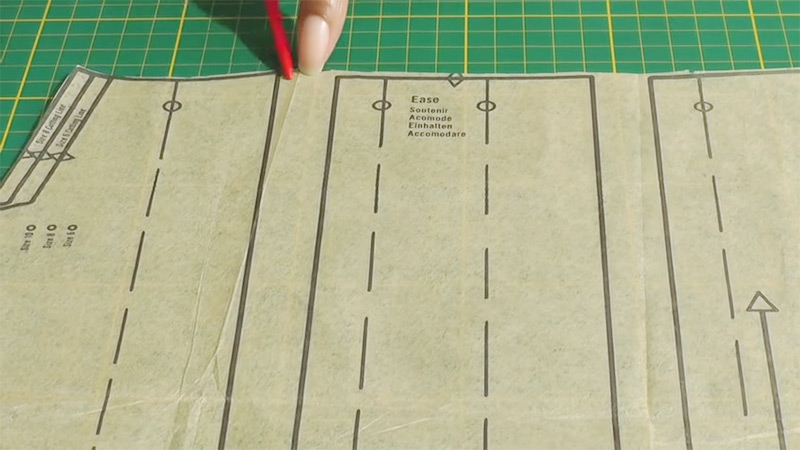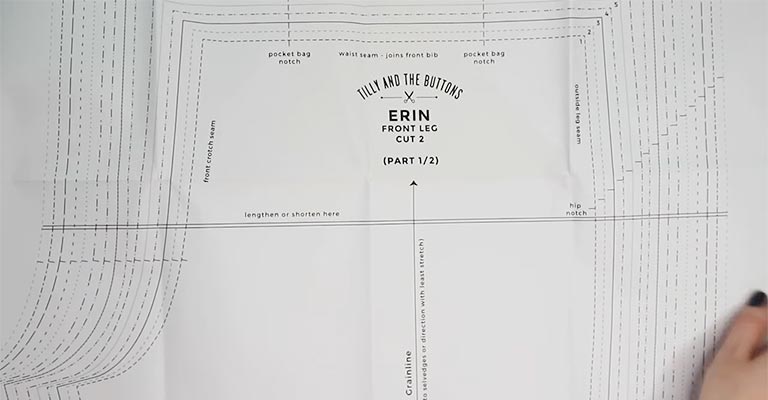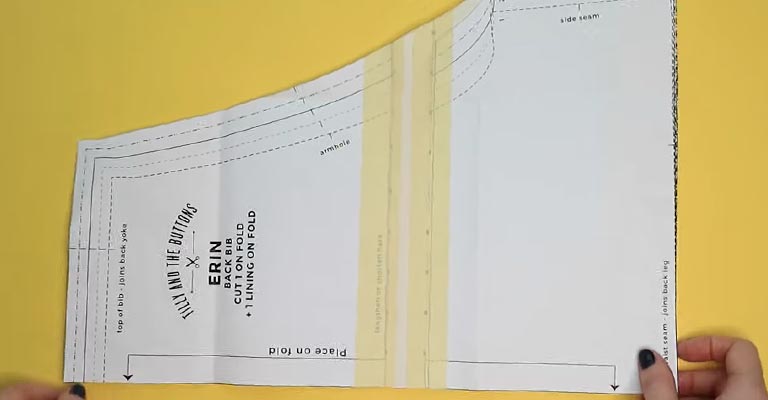Sewing pattern symbols are the secret language of the sewing world, a code that conveys essential instructions and details to those who craft garments and textiles.
These symbols, found on paper patterns, serve as a visual guide for cutting, aligning, and stitching fabric pieces together.
Understanding the intricacies of these symbols is a fundamental skill for anyone venturing into the world of sewing. Whether you’re a seasoned seamstress or a novice enthusiast, these symbols are the key to unlocking creativity and precision in your sewing projects.
In this article, we delve into the world of sewing pattern symbols, exploring their meanings and significance in the art of garment construction and textile design.

What Are Sewing Pattern Symbols?
Sewing pattern symbols are a set of standardized graphical elements and notations used in sewing patterns to provide instructions and information to the person sewing a garment or project.
These symbols help users understand how to cut out fabric pieces, align them, sew them together, and add various details.
Here are some common sewing pattern symbols:
Grainline
The grainline symbol, often represented as a straight line with double-ended arrows, is the foundation of every sewing project. It tells you how to position the pattern piece on the fabric in alignment with the fabric’s grain.
This is crucial because the fabric has a natural grain direction, and placing the pattern piece correctly ensures that the garment drapes and fits correctly.
Fold Line
The fold line symbol, usually depicted as a line with one open end and one dashed end, instructs you to place the pattern piece on the folded edge of the fabric.
Cutting along this line results in two identical, mirror-image pieces, typically used for the front and back sections of a garment.
Notches
Notches are small, often triangular or diamond-shaped marks found along the edges of the pattern pieces.
These marks are like puzzle pieces that ensure different pattern pieces align perfectly during the sewing process, guaranteeing seamless seam connections and preventing fabric distortion.
Darts
Darts are frequently marked with V-shaped or diamond-shaped symbols. These symbols indicate where you should fold the fabric and sew to create shape and contour in the garment.
Darts are your secret weapon for achieving a well-tailored fit, as they eliminate excess fabric while maintaining the desired curves.
Seam Allowance
Sewing patterns include dotted lines or labels that indicate the recommended seam allowance for each seam. The standard seam allowance is typically 5/8 inch (1.5 cm), but it can vary based on the pattern.
These lines ensure your sewing lines are evenly spaced and lead to a polished finish.
Button and Buttonhole Placement
Button symbols, often represented as circles, and buttonhole symbols, typically resembling vertical bars, indicate where to attach buttons and create buttonholes. Some patterns may include numbered labels for precise button placement.
Gathers and Pleats
Special symbols and notations highlight where to create gathers, pleats, or tucks to add fullness and detailing to your garment. These techniques enhance the design and add sophistication to your creations.
Lengthen or Shorten Lines
Lengthen and shorten lines, marked with arrows and notations, offer the ability to customize pattern pieces to accommodate individual body proportions. You can cut along these lines, either spreading them to lengthen or overlapping them to shorten, them to achieve a personalized fit.
Size Markings
Size labels are essential for selecting the right pattern size based on your body measurements. This helps you avoid unnecessary alterations and streamlines the sewing process.
Grading Lines
Grading lines are typically marked with size labels and assist in transitioning between different sizes on the pattern. This allows for a seamless blending of sizes to create a custom fit.
Pattern Piece Identification
Each pattern piece is labeled or numbered for easy identification. These labels assist you in matching and assembling the pieces accurately, ensuring that you follow the pattern instructions with precision.
Why Are Sewing Pattern Symbols Important for Successful Sewing Projects?

Sewing pattern symbols are indispensable for ensuring the success of sewing projects. These symbols provide a visual language that communicates essential information and instructions to the sewist, guiding them through the entire garment or project creation process.
Here are the key reasons why sewing pattern symbols are crucial for successful sewing projects:
Precision and Clarity
Sewing pattern symbols offer precise, visual instructions on where to cut fabric, where to fold, and where to sew. They eliminate ambiguity and guesswork, ensuring that every step is executed accurately.
Consistency
Consistency is essential in sewing. Sewing pattern symbols establish uniformity in seam allowances, darts, and other details across all pattern pieces. This consistency results in a professionally finished garment with a harmonious look.
Customization
Understanding these symbols empowers sewists to customize patterns to their unique measurements and preferences. Lengthen or shorten lines, for example, allow for personalized adjustments, ensuring a perfect fit and tailored look.
Efficiency
Sewing pattern symbols streamline the sewing process, saving time and reducing fabric waste. By knowing precisely where to cut and how to assemble pieces, sewists work efficiently and make the most of their resources.
Professional Results
These symbols are the keys to achieving professional-level results. They enable sewists to replicate the intended design faithfully, leading to well-constructed garments with clean lines, balanced proportions, and a polished appearance.
Error Prevention
Misinterpreting patterns can lead to costly errors. Sewing pattern symbols act as a safeguard, reducing the chances of mistakes and saving both time and materials.
Fit and Comfort
Sewing pattern symbols, such as darts and notches, are essential for achieving the correct fit and comfort in garments. They ensure that fabric drapes properly provide shaping, and match accurately at seam intersections.
Efficient Assembly
These symbols guide the placement of buttons, the creation of buttonholes, and the attachment of pockets. Knowing where and how to place these elements streamlines the assembly process, reducing errors and ensuring a well-organized workflow.
Versatility
Sewing pattern symbols aren’t confined to clothing patterns. They are equally valuable for various sewing projects, including crafting accessories, home decor, and more. Their versatility ensures that each project is completed with precision and care.
How Can You Master the Language of Sewing Pattern Symbols?

Mastering the language of sewing pattern symbols is a valuable skill for anyone working with sewing patterns. It ensures that you can accurately interpret and execute pattern instructions.
Here are some steps to help you become proficient in understanding and using sewing pattern symbols:
Read Pattern Instructions
Start by thoroughly reading the instructions that accompany the sewing pattern. Pattern instructions often include a key or legend that explains the symbols used in the pattern. Familiarize yourself with this key as your reference guide.
Study the Key
Pay close attention to the pattern key or legend provided in the instructions. This key lists the symbols used in the pattern along with their meanings. Take the time to understand each symbol and what it represents.
Practice with Scrap Fabric
Before tackling a major sewing project, practice with scrap fabric. Choose a simple pattern or section of a pattern to work on. This hands-on experience will help reinforce your understanding of pattern symbols.
Use a Magnifying Glass
Some patterns may have small or intricate symbols that can be challenging to discern. Using a magnifying glass can be helpful for examining these symbols in detail.
Take Notes
While working with patterns, jot down notes about the symbols you encounter. You can create your own reference guide with sketches and explanations to refer back to in the future.
Consult Sewing Resources
There are many sewing resources available, including books, online tutorials, and sewing forums. These resources often provide explanations and visual guides for common sewing pattern symbols. Utilize these references to reinforce your knowledge.
Attend Sewing Classes
Consider taking sewing classes or workshops, either in person or online. Instructors can provide hands-on guidance and explanations for interpreting and working with sewing pattern symbols.
Start with Simple Patterns
Begin with simpler patterns that have fewer symbols and instructions. As you gain confidence, you can gradually tackle more complex projects with a wider range of symbols.
Ask for Guidance
Don’t hesitate to seek help from experienced sewists or instructors if you encounter symbols that you find confusing. They can offer valuable insights and tips.
Create a Sewing Journal
Keep a sewing journal where you document your experiences with different patterns, including the symbols you encountered and how you interpreted them. This can serve as a valuable reference for future projects.
Repeat Patterns
Repeating patterns or using the same pattern multiple times can reinforce your understanding of symbols. You’ll become more familiar with the common symbols used in patterns and their interpretations.
Learn by Doing
Ultimately, the best way to master sewing pattern symbols is through practice. As you complete more sewing projects, you’ll gain confidence in interpreting and using the symbols effectively.
FAQs
Are there specialized sewing pattern symbols for specific garment types, like dresses, pants, or shirts?
While many sewing pattern symbols are universal, some designers may introduce specific symbols for unique design elements in their patterns. Always refer to the pattern key or instructions for any specialized symbols.
Can I use sewing pattern symbols when drafting my own patterns from scratch?
Yes, sewing pattern symbols are valuable when creating custom patterns. You can use them to indicate grainlines, darts, seam allowances, and other essential details in your pattern drafts.
Are there international standards for sewing pattern symbols, or can they vary by country or region?
There are general conventions for sewing pattern symbols, but some variations may exist between countries or regions. It’s best to refer to the pattern key or instructions provided with each specific pattern to ensure accuracy.
Can I create my own sewing pattern symbols for personal use, or should I strictly follow established symbols?
While it’s essential to understand and use established sewing pattern symbols, you can create your symbols or notations for personal use as long as they are clear and consistent in your sewing projects.
Do sewing pattern symbols include symbols for different fabric types or textures?
Sewing pattern symbols primarily focus on construction details rather than fabric types or textures. However, fabric recommendations and guidelines are typically provided in the pattern’s instructions.
To Recap
Sewing pattern symbols are the unsung heroes of the sewing world. These seemingly cryptic markings are the linchpin that connects a pattern’s design to its physical manifestation in fabric.
They ensure precision, consistency, and customization in sewing projects, from clothing to home decor. Understanding these symbols is not just a skill; it’s a gateway to unlocking your creative potential and achieving professional-quality results.
By mastering the language of sewing pattern symbols, you gain the power to turn flat fabric into beautifully tailored garments and crafted textiles.
So, whether you’re a novice or a seasoned pro, embracing and interpreting these symbols is a vital step on the path to sewing mastery.
Leave a Reply